
Beyond demographics: how to research your target audience
Advertisers and marketers have long understood that when an audience interacts with a brand, movement, trend, campaign or idea, they don’t do so as a simple monolith, but instead through a prism of different perspectives, contexts and behaviors.
As societies continue to diversify, understanding the composition of your own target audience – and defining that audience – is only becoming more important. This practice is known as audience research, or audience analysis.
We’ll explore its meaning and application of the term within this guide, which will cover:
- What is audience research?
- The importance of audience research in marketing
- How to conduct audience research
- Audience research for brands
- Audience research for subcultures
- Audience research for products
- Audience research for content
Unfortunately, no aspect of marketing research can be said to be truly predictive (regardless of what cold emails might tell you). But by equipping yourself with a deep understanding of the audience you’re attempting to reach, you can not only deliver greater efficiency in time, cost and effort expended, but also better measure the impact of a given campaign or business decision.
What is audience research?
Audience research can be defined as the process by which a marketing, communications or research function sets out to advance their understanding of a group.
Why they do this can vary. Often a brand might launch this activity to understand how their customer base has evolved. Alternatively they may wish to map out the audience into which a new product or service might be released into. And there’s any number of reasons, outside of brand marketing, why audience analysis can be a good idea. A healthcare institution, for instance, might discover who’s driving public perception around a particular condition. A charity could identify how the social dynamics among its advocates differ to other causes.
But the first thing to do, before applying any analysis, is define what group – or audience – you wish you study. You want to understand your audience – but how to you select them in the first instance?
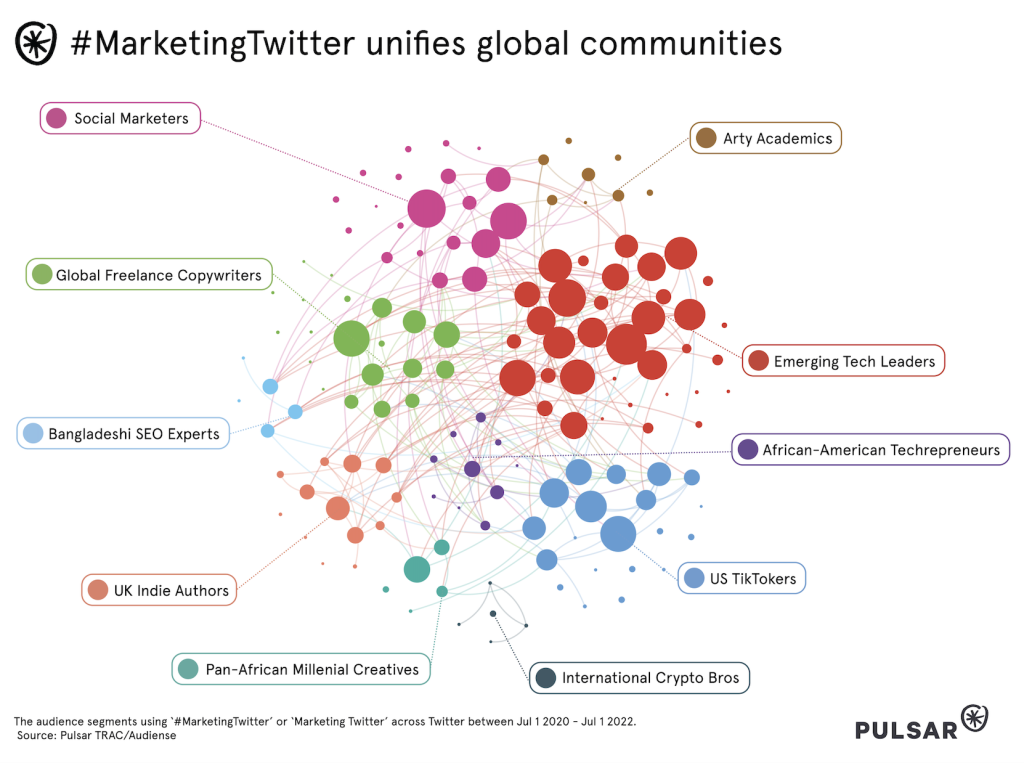
The audience can range massively in size and characteristics, and can be defined according to any number of conditions. These could be reflections of their own active behavior and preference (such as affinity towards a particular brand, product, hobby or piece of culture), or else a product of more situational qualities, like demographic or location data.
When the data used focuses on factors like interests, attitudes and values, it’s known as Psychographic data. When it focuses on behaviors, such as which websites they visit or which platforms they most commonly use, it’s Behavioral. Together with Demographic, these make up the three primary data types within audience research.
How to research the right audience, and the process of identification this entails, is the most crucial part of the process. After all, looking intently in the wrong direction is very often worse than not looking anywhere at all. Thankfully, individuals voluntarily provide us with all sorts of indicators and clues as to who they are, and how they behave.
One such way is through the use of questionnaires. Government authorities, but also public health bodies and academic institutions, will often produce their own questionnaires. Clearly, though, this is an unrealistic option for most brands, who are able to release customer surveys, but nothing on a comparative level of scale or representativeness.
So what can brands do? One option is to access a database that collates a colossal number of questionnaire answers. This type of approach to consumer insights is one utilized by companies such as GlobalWebIndex, and can prove an invaluable tool to brands.
What we’re going to focus on though, is the approach provided by using audience intelligence.
What is the importance of audience research in marketing?
As we’re already inferred, audience research and analysis is an essential building block within any marketing strategy.
On one level this is a matter of focus. When the main methods of delivering advertising messaging came through mass communication, such as television, radio and print, it was understood that simple logistics – and often a paucity of alternatives – meant captive audiences who remained relatively static in their habits.
Clearly, this has changed beyond all recognition, as a number of different content types, online communities and even platforms have distributed eyeballs across a plethora of different spaces. A 25 year old man from Leeds might share an age and ethnicity with his neighbor, for instance. But if one regularly attends dance lessons and is addicted to telenovelas, while the other is a dedicated crossfitter with a weakness for cute dog videos, then the two are unlikely to share many of the same cultural touchpoints.
Traditional marketing strategies would not account for this difference, so long as the demographic data remained consistent. And so in-depth audience research became an essential part of any strategy, to prevent marketing and communications teams from busily, and with great dedication, unloading huge amounts of ad spend and attention on ‘potential’ customers who were never going to take that step into ‘actual’ consumers.
And it’s here that audience intelligence comes in.
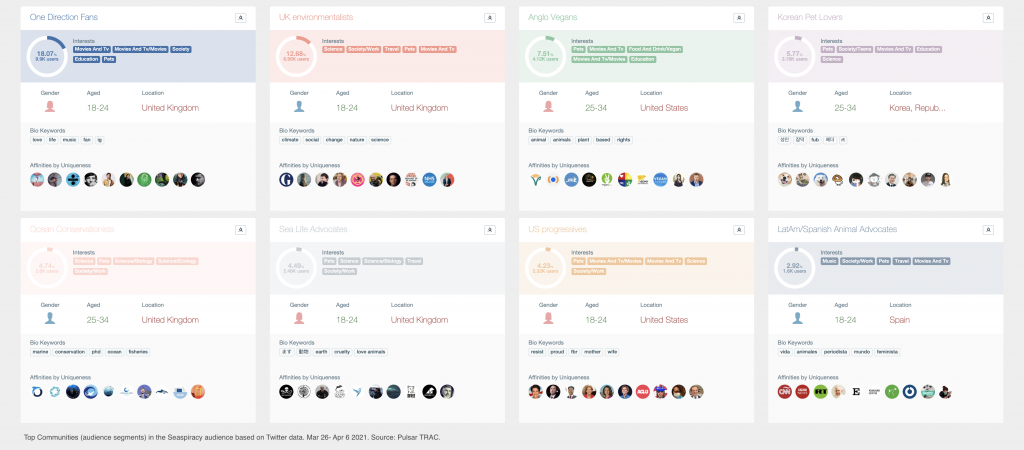
A focus group, say, can allow for more freedom and qualitative insight than a questionnaire, but at nothing like the level a brand would find useful. If a brand can fit its customer base into a single room, then it’s likely in pretty serious trouble.
Audience intelligence fills that gap, giving users the capacity to map and understand any conversation taking place across social, news, forum and search platforms. In essence, the online platforms we inhabit become an enormous focus group.
So what does this look like in practice?
How do you conduct audience research?
Questionnaires and focus groups are both very valid means of discerning audience insights. For the focus of this guide, however, we’ll be focusing on what it means to deliver insight at scale.
Emailing reviews and surveys to a client base is one way of activating an already invested audience, and discovering their attitudes. The very way in which this data is collected, however, conditions the types of response the researcher will receive. For one thing, the pool of respondents already has established a relationship with your brand, and the individuals most likely to take time to fill in a form are likely to be more engaged still. As a result, this method is suitable for product marketing and certain categories of insight, but doesn’t reveal the kind of exploratory insight a marketer might wish to unearth around a potential consumer base, for instance.
Adopting an approach rooted in social listening and audience intelligence, on the other hand, means observing conversations as they play out across social platforms. Observing the opinions individuals share when within the context of an online community, rather than within a formalized question-and-answer session with a company representative, allows for more authentic insight. Buyer Persona’s become truer reflections of real individuals and groups of people.
It’s important to first understand where the conversations around a topic are taking place. Often, a conversation will unfold across multiple different platforms, in a fashion unique to that platform’s own mechanics and demographic. Reddit and Facebook, for instance, play host to more in-depth text-based conversations, in which users self-select by contributing to subreddits and public Facebook pages orientated around a specific interest. On more image-based platforms like TikTok and Instagram, meanwhile, a user might select a certain hashtag or song, another act of self-identification that helps a marketer or researcher better define a particular group.
Naturally, there are also myriad other ways to understand an audience online, such as through affinity and interconnectivity with other users. By exploring five distinct use cases, we’ll aim to illustrate the range of insights that sound audience analysis can deliver.
Conducting audience research for brands
GivingTuesday are a global generosity movement who began life as a hashtag, before evolving into a charitable brand with name recognition well beyond the USA.
This evolution has corresponded to a significant shift in their audience composition. To understand what level of change has taken place, and how that might impact their strategy and messaging, GivingTuesday used Pulsar TRAC to map what their audience looked like at several stages within their growth journey.
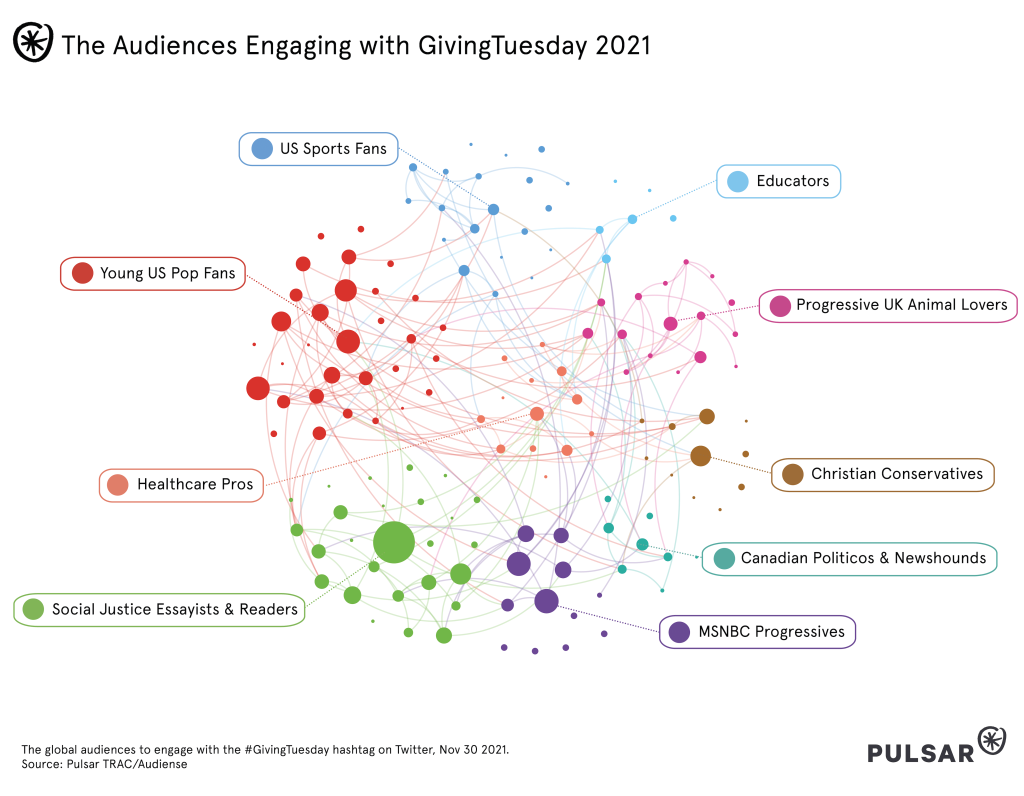
This type of segmentation is powered by artificial intelligence, clustering the segments taking in part within any given conversation according to their shared affinities and interconnectedness. Educators, for instance, share an interest in accounts and platforms centered on educational materials, allowing us to make inferences around their motivators, interests and professional life.
The number of nodes corresponds to the size of this segment within the wider audience, while the size of the nodes shows how interconnected that particular segment is within the audience. In the above example, Social Justice Essayists and Readers are revealed to have far more common points of connection with other segments than US Sports Fans, for instance.
Insights like these can underpin brand marketing strategies within organizations. This type of visualization informs a marketer which groups remain constant, which come and go, and which mutate as communities and interests shift. What’s more, understanding that the audience engaging with your brand is not just segmented and dynamic, but also interconnected to varying extents, can influence the impact and KPIs of particular campaigns and communications strategies. Some segments are better at disseminating information, both amongst themselves and more widely. Others might appreciate being spoken to in a particular way, but are simply less likely to project this messaging further.
Audience research for subcultures
A brand might reasonably be expected to have a solid grounding in who makes up its base, with much of the new insight coming through hidden facets, nuance and complexity. That’s less the case when setting out to research a subculture. In these instances, the audience analysis becomes far more exploratory in nature.
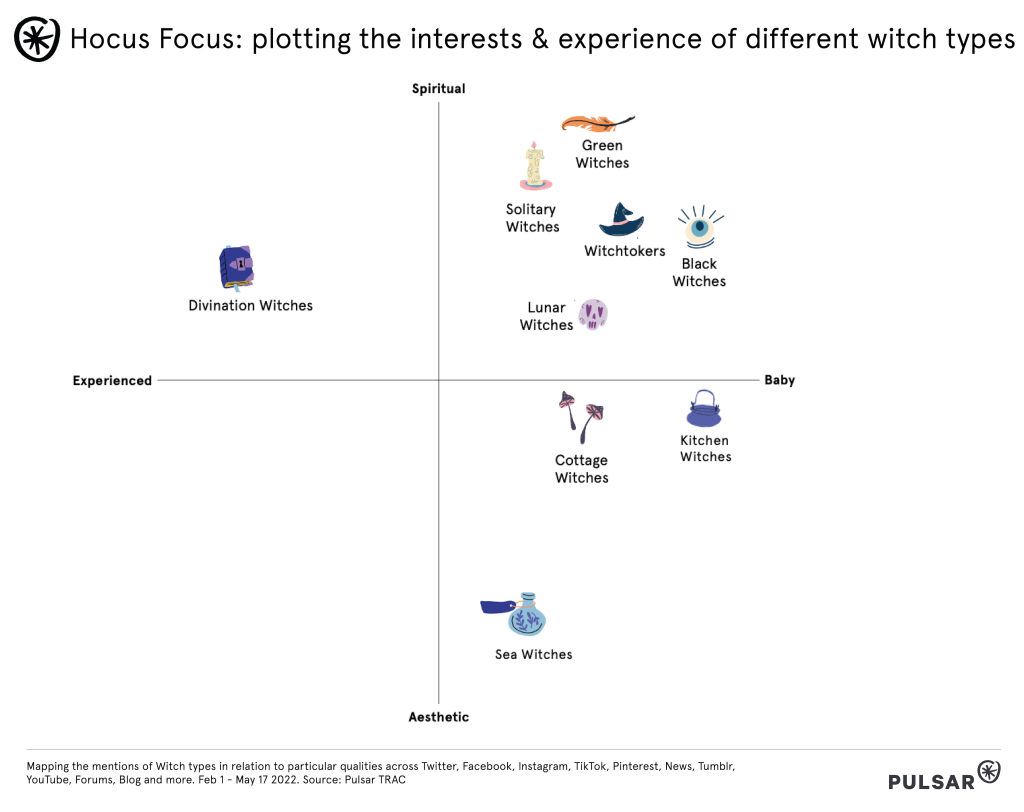
In this particular instance, we explored the attitudes and behaviors of communities affiliated with the witch subculture. Many such subculture members are very open to self-identifying across safe and accommodating spaces, like anonymised forums, which provides us with one option for understanding this culture.
Another option was to hone in on the self-identified witches active on Twitter. Again, by aggregating the shared affinities and behaviors of this community, we were able to use Psychographic and Behavioral data to gain a more nuanced understanding beyond simply self-identification.
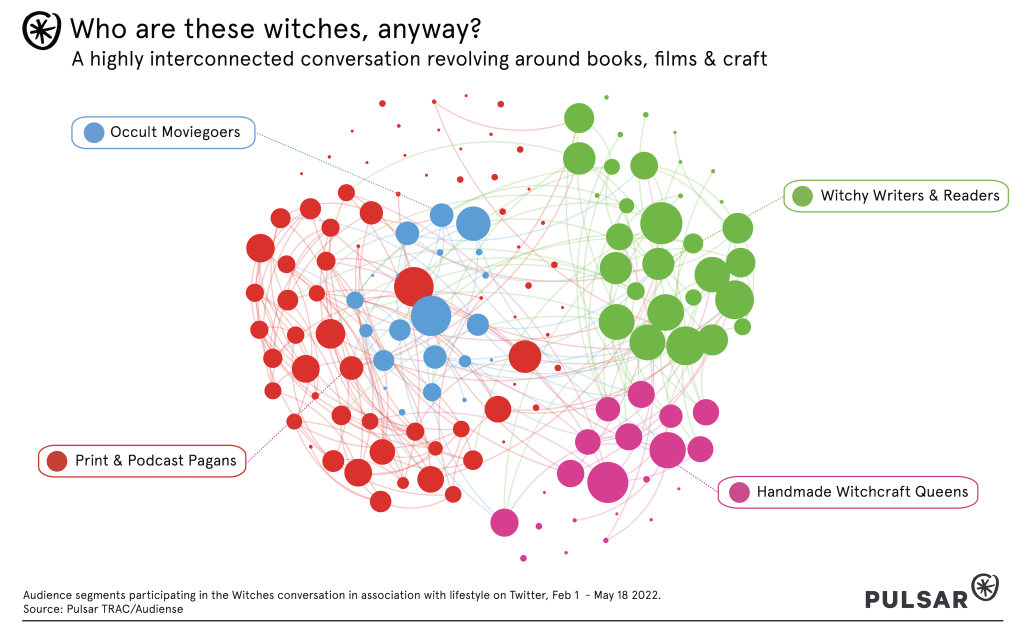
In this particular example, the differing communities were predominately distinguished by their preferences for Books, Movies, Podcasts and Handcrafting. Given the difficulties brands encounter in talking to this subculture, a more nuanced understanding might have prevented the kinds of backlash that took place around Sephora’s witch kit release. Knowing what aspects of your audience will and won’t accept, as well as the language and influential figures that hold sway in that space, should underpin any marketing strategy directed at a subculture.
Audience research for products
Audience analysis can also be used to understand how people interact with a specific category of product.
In this example, we compared the overall US energy bar audience with that which gravitated towards two of the market’s biggest brands: Clif and Quest.
It allowed us to dig a little deeper into the conversation around a highly popular product topic, both in the assumptions that it supported (such as the prevalence of health and fitness buffs), and in other, more surprising insights (including a notable gamer presence and, sadly, the popularity of certain bars amongst those suffering with eating disorders.)
Audience research for content
Each of the examples given so far have focused on the largescale audiences that can attach over time to a brand, culture or product. But it’s also possible to apply such analysis to something far more transient – namely, content.
In this instance, we’ve mapped the changing audience around the MGMT song ‘Little Dark Age’, but a similar analysis could be performed on a TV show, movie, game and even memes.
Given that the nature of online spaces can see pieces of content co-opted, claimed and re-contextualised, it’s increasingly important that entertainment companies understand how the audience around a piece of content might change – both to prevent PR backlashes and to remain alive to new commercial opportunities.
But beyond this, all companies with a social media presence and active marketing can benefit from tracking the performance of a piece of content, and the campaign it sits within.
Understanding your target audience, and which people comprise both ideal and potential customers, is a vital piece of research for brands to engage in. Audience intelligence supports the distinctive approach an individual marketer or researcher brings to problem-solving, allowing them to build a strategy rooted in genuine insight.


